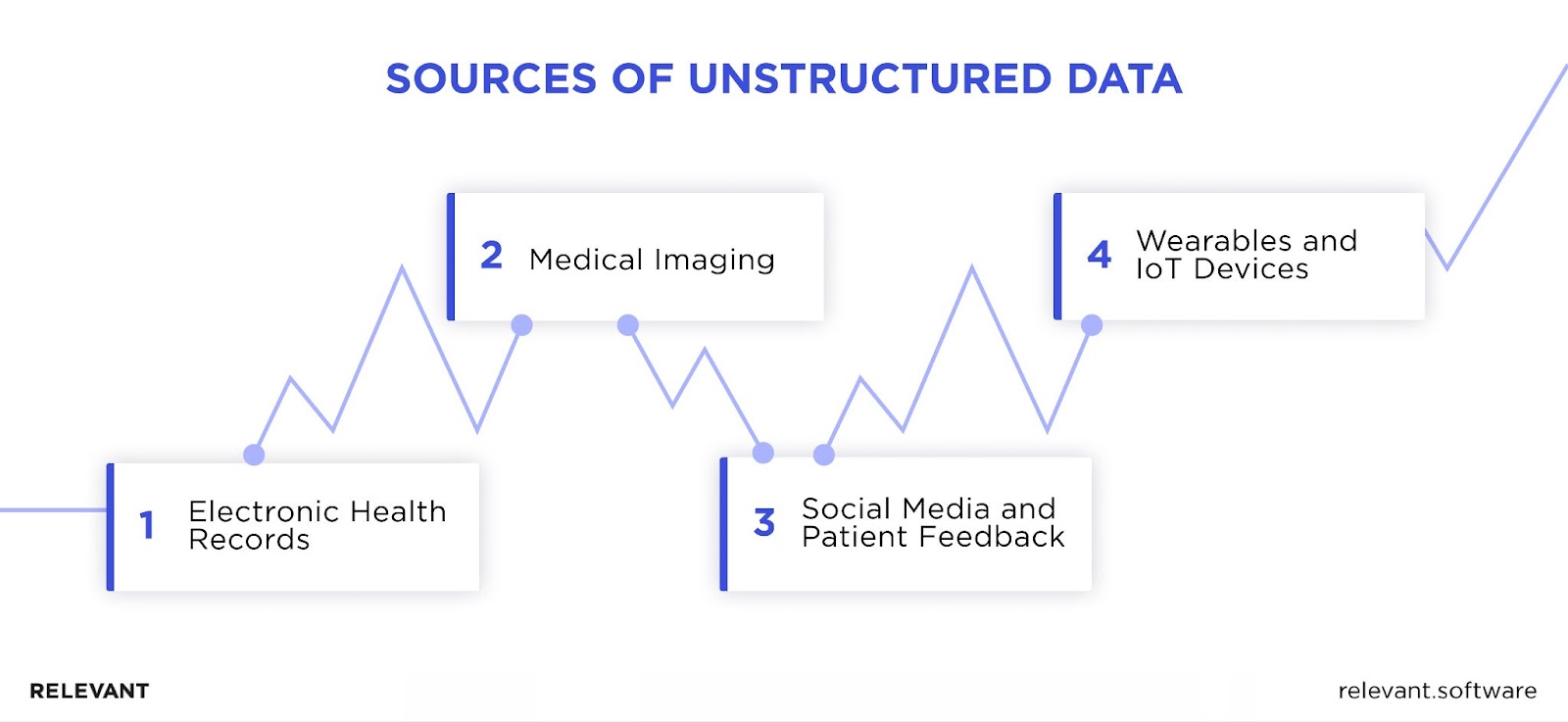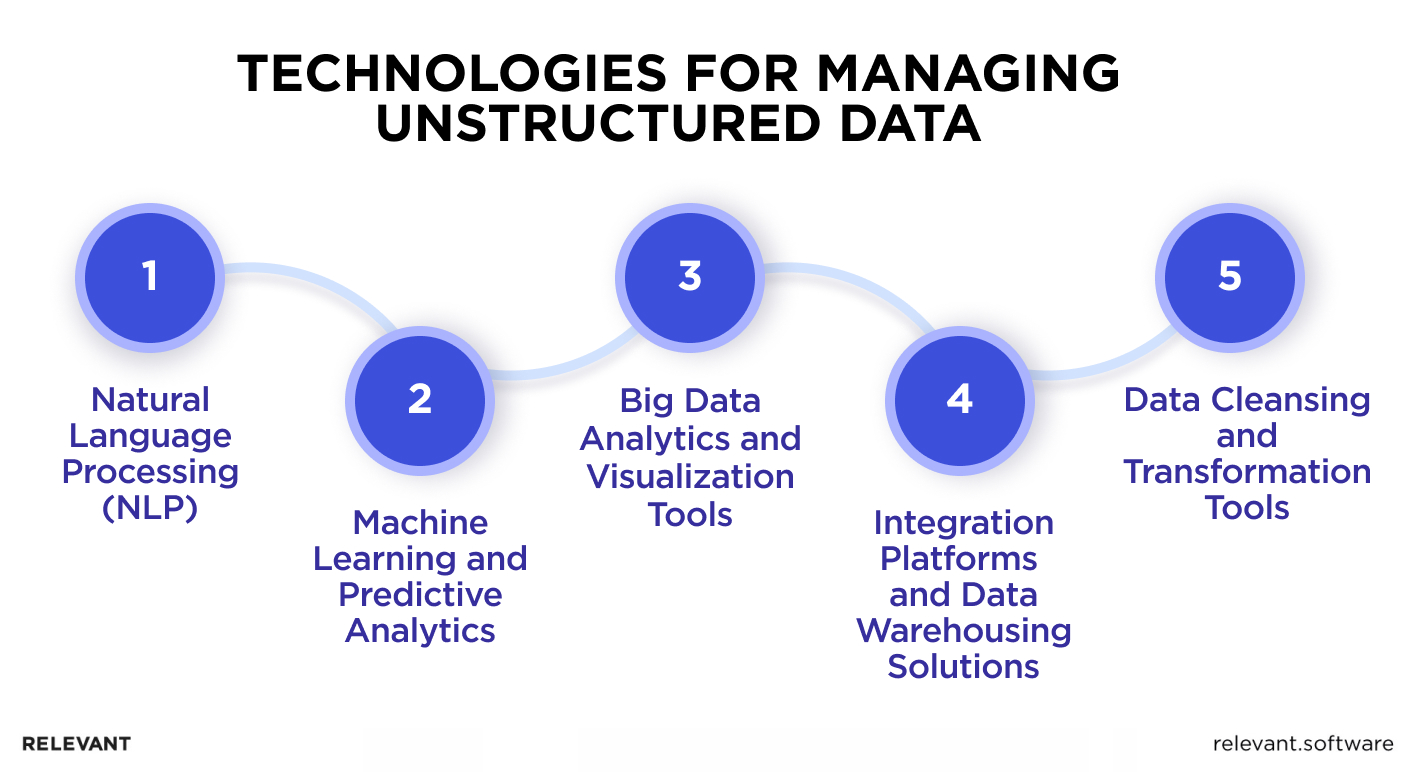Unstructured Data in Healthcare: The Landscape, Challenges, and Opportunities
Updated: June 4, 2025
Consider this fact from IBM research: throughout a person’s life, they’ll generate over 1 million gigabytes of health-related data. This isn’t just the basic stuff. We’re talking about everything – from electronic health records (EHRs) to those detailed X-ray images. All of this can be a powerhouse for better treatment and diagnosis. But here’s a hidden challenge. Over 80% of these resources are unstructured data in healthcare and are often not easy to access.
And if that wasn’t enough, many healthcare institutions have such data locked in separate storage spots. So, piecing it all together? It’s not as easy as it sounds. To find answers, read our article. Here, we crave to figure out the complex world of unstructured healthcare data, highlighting its challenges and potential. By the end, we’ll show how proper healthcare software development can unlock this data, making it usable and meaningful.

We provide companies with senior tech talent and product development expertise to build world-class software. Let's talk about how we can help you.
Contact usTable of Contents
Unstructured Data in Healthcare: An Introduction
When discussing healthcare data, most people picture neatly arranged numbers in rows and columns. That’s just the tip of the iceberg. Here’s a simple breakdown to clarify the landscape of structured and unstructured data in healthcare.
- Structured Data: Think of this as the backbone of our healthcare information. It’s the organized, systematic data you might be familiar with. If you’ve ever seen a patient’s chart with temperature readings, blood work results, or even vaccination dates, that’s structured data in action. The value of structured data lies in its predictability—it’s easy to process, sort, and analyze with software tools.
- Unstructured Data: This is where things get a little more complicated. Behind charts and tables lies a world of ideas that are often overlooked. Imagine a doctor’s handwritten notes describing a patient’s behavior or a voice recording of a consultation. They don’t fit into standard tables but are critical to understanding the bigger picture. They capture nuances, feelings, and subtle metrics that may not be immediately obvious in a numerical format.
Now, why does this matter? In the evolving landscape of healthcare, every piece of information is pivotal. While structured data lays the foundation, unstructured data brings in-depth context. Embracing both ensures we don’t just treat patients based on numbers but understand their stories, leading to more personalized and effective care.
Significance of Unstructured Data in the Healthcare Field
Healthcare has always been data-driven, and lately, there’s been a growing appreciation for unstructured data. Now, while structured data gives us tangible metrics like blood pressure readings or cholesterol levels, unstructured data delivers the nuances and insights that go beyond these measurements.
Think of it this way: structured data might tell you that a patient’s heart rate increased during their last visit. Still, it’s the unstructured data – like a doctor’s notes on the patient’s apparent anxiety or a narrative on the patient’s recent life events – that offers the fuller picture. This kind of data doesn’t fit neatly into data tables and charts, but it’s rich in context. It’s about understanding the whole person, not just the numbers associated with them.
Moreover, as we dive deeper into the era of advanced technology in healthcare, there’s a growing reliance on diagnostic tools that produce massive amounts of unstructured data. Think about the detailed visual outputs from state-of-the-art MRIs and CAT scans or the rich textual data in genetic sequencing reports. This data isn’t just a jumble of numbers and letters; it’s a reservoir of patterns and predictions, holding the potential to guide us to innovative treatments.

But there are hidden problems with unstructured data in healthcare—for example, a chest X-ray can be up to 15 megabytes, a 3D mammogram can be 300 megabytes, and a digital pathology file can be 3 gigabytes—the size of a high-definition movie. Processing these forms of data requires additional software with special algorithms.
Nevertheless, it opens great opportunities. Recognizing this data and making sense of its meaning can help in better decision-making that enhances patient experiences by improving overall healthcare practices.
Types of Unstructured Data in Healthcare
Now, let us look at the different types of unstructured data that exist within healthcare:
| Data Source | Description |
| Clinical Notes | Records by medical professionals detailing a patient’s symptoms, treatments, and overall health status. |
| Medical Imaging | Images obtained from tools such as MRI, CT, and ultrasound show the internal structures of the body, which helps in diagnosis and treatment. |
| Transcription Records | Written accounts of discussions between patients and healthcare providers, revealing patient concerns, medical history, and suggested care paths. |
| Emails & Text Communications | Direct interactions between patients and healthcare providers often provide important feedback or additional health information. |
| Outputs from Wearable Devices | Information from devices such as fitness trackers that monitor health metrics, including heart rates or sleep cycles. |
| Genomic Data | Details from an individual’s DNA reveal potential health risks or genetic markers. |
| Multimedia Content | Various resources like videos or diagrams designed to help patients understand their conditions and treatments. |
Various Sources of Unstructured Data in Healthcare
When we unpack the idea of “what is unstructured data in healthcare,” we quickly realize it’s everywhere:

Electronic Health Records (EHR)
You might think of EHRs as structured, but they’re packed with unstructured data. Between those drop-downs and checkboxes, there’s a text filled with patient stories, doctors’ scribbles, and loads of insights. These insights can sometimes convey nuances that a standard blood test might miss. Discover the profound impact of Electronic Health Records on healthcare delivery.
Medical Imaging
Medical imaging is one of the typical unstructured data examples healthcare deals with. Think of these as the silent storytellers of healthcare. MRIs, X-rays, CT scans—they’re more than just pictures. They give a profound look into our health. But since they’re not your typical spreadsheet data, they need some special handling both in analysis and storage.
Social Media and Patient Feedback
In today’s digital age, patients voice their experiences everywhere—social media platforms, forums, and feedback sites. These raw, firsthand accounts, when analyzed correctly, can be gold mines for understanding and elevating patient care.
Wearables and IoT Devices
We’re in a tech era where our wristbands tell more about our health than some clinic visits. Devices that track our heart rate, sleep, and even sugar levels are pouring in data daily. It might seem overwhelming, but with the right approach, this info can be pivotal for preventive care and tailor-made treatments.
In essence, while this flood of unstructured data in healthcare might sound daunting, especially in terms of storage, it’s these very sources that can give caregivers a holistic understanding of patient health, leading to more effective care decisions.
Challenges in Handling Unstructured Data in Healthcare
The healthcare industry is no stranger to innovation and evolution. Yet, as it adapts to incorporate a broader spectrum of data, certain challenges tied to managing unstructured data come into the limelight. Let’s unpack these complexities to appreciate the hurdles and the potential solutions better.
Issues Regarding Security and Privacy of Data
Unstructured data, by its very essence, spans a broad spectrum—from clinical observations to personal email exchanges. Such data is often sensitive, requiring heightened security measures. Beyond just protecting this data, healthcare institutions, in line with directives like HIPAA, are duty-bound to uphold patient privacy. This means ensuring not only that patient data is secure but that it can only be reasonably accessed by those authorized to view it.
Integration And Standardization Issues
With no uniform format, merging unstructured data with established healthcare systems is no mean feat. For instance, how does one seamlessly integrate free-text clinical observations into a neatly structured EHR system? To bring a semblance of order to this chaos, not only do we need advanced software tools, but sometimes, a touch of manual intervention is unavoidable.
Ethical Concerns
The accumulation of unstructured data, particularly when it’s patient-generated, must rely on the ethics of informed consent. Are patients aware of how their data is being leveraged? Do they understand the consequences of this? Ensuring ethical handling means institutions need to be transparent about data usage, securing permissions, and ensuring clarity in communications.
Difficulties in Scalability and Performance
The sheer volume of unstructured data, coupled with its rapid expansion, can strain storage infrastructures and affect system performance. One can imagine the space needed to house incoming medical images or continuously added wearable device data. The big challenge here is scalability: ensuring that systems have room for this flow and perform well during search and analysis.
So, how to overcome unstructured data in healthcare? To harness the power of unstructured data in healthcare, there’s a clear mandate for technological innovation, stringent oversight, and relentless vigilance.
Technologies for Managing Unstructured Data in Healthcare
In today’s digital environment, we are overloaded with huge volumes of data that are not always clearly structured. Fortunately, we possess advanced tools that not only facilitate the management of such data but also enable us to extract pertinent information from it. Here’s an exploration of key technologies driving this transformation.

Natural Language Processing (NLP)
NLP aims to equip computers with the capacity to comprehend human language, much like we do. It enables machines to read, discern, and even generate text in ways that resonate with human understanding. For businesses, this means the ability to extract useful information from huge volumes of text data – be it customer reviews, correspondence or extensive reports. Consider the ability to swiftly analyze a multitude of product feedback to ascertain customer satisfaction levels. With NLP, this is not merely an idea; it’s an operational reality.
Machine Learning and Predictive Analytics
Machine Learning, an offshoot of AI, focuses on enabling systems to derive knowledge from data, identify patterns, and subsequently make decisions grounded in these patterns. Predictive Analytics, true to its designation, harnesses this data to anticipate potential future events. For example, in a medical context, these methods might be employed to assess patient data and foresee potential health complications. For commercial entities, it might mean forecasting market trends rooted in historical data. Essentially, it empowers us to strategize today with insights into probable future scenarios.
Big Data Analytics and Visualization Tools
The task of managing colossal amounts of data is greatly simplified by big data analytics, which skillfully processes and evaluates such data. Visualization tools enrich this process by rendering intricate data sets in graphical formats that simplify comprehension. Imagine transforming multifaceted data into graphical narratives that explain a consistent story in healthcare analytics services. By providing unstructured data analytics in healthcare, big data engineers aid decision-makers in extracting immediate insights, facilitating informed choices without the need to grapple with extensive raw data.
Integration Platforms and Data Warehousing Solutions
With organizational expansion comes an inevitable surge in data generation. Integration platforms serve to combine data from various sources to provide a consolidated data foundation. Concurrently, data warehousing solutions provide a centralized depot where this combined data can be housed, retrieved, and scrutinized. Effective data stewardship extends beyond mere storage; it encompasses preserving data veracity and ensuring its ready accessibility to inform decision-making processes.
Data Cleansing and Transformation Tools
Regardless of the complexity of our data processing tools, their effectiveness depends on the quality of the input data. Data often arrives tainted with inaccuracies, inconsistencies, or redundancies. Data Cleansing tools are designed to address and rectify these imperfections, ensuring data precision and uniformity. Following this, Transformation tools reformat this refined data, prepping it for subsequent analysis. This foundational step is crucial to guarantee that our analytical endeavors and forecasts are anchored in credible and dependable data.
In conclusion, despite posing some challenges of unstructured data in healthcare, it has turned to more sophisticated technological tools that streamline management and extract key insights from this vast data reservoir. It ensures that any potential benefits of unstructured data in healthcare dissipate when it is used.
Real-World Implementations of Unstructured Data in Healthcare
With modern data tools and techniques, medical professionals are able to provide quality medical care by understanding individual diseases better. Some realized ideas for using unstructured data in healthcare are being presented below:
Diagnostic Improvements Using Unstructured Data
Let’s get real for a moment. Medical professionals deal with loads of data daily, and not all of it is numbers and charts. Medical images, from X-rays to MRIs, and other similar examples of unstructured data in healthcare aren’t something you can just slot into a spreadsheet. Yet, when you couple these images with related notes and observations, they’re a goldmine. Modern tools help us make these visual data and associated notes machine-readable, providing richer context and clarity. The end result? Doctors and medical staff get to see a fuller picture and can make more informed decisions.
Patient Engagement and Experience Enhancement
Everyone has a story to tell, especially patients. Are those notes and feedback left by patients? They’re not just passing comments; they’re insights. By paying attention to what patients are saying, healthcare providers can identify what’s working and where they need to step up. It might be something as basic as streamlining appointment procedures or as vital as refining the way patient concerns are addressed. By acting on this feedback, healthcare facilities can offer care that’s in tune with what patients truly want and need.
Remote Monitoring and Telemedicine Support
With the tech advancements we’ve seen recently, distance isn’t a barrier anymore. Wearable gadgets and health apps are more than just fancy tech; they’re the new frontier in healthcare. These tools offer real-time health data, everything from heart rates to sleep cycles. Pair this with input from virtual doctor visits, and professionals have everything they need to give sound advice, no matter where the patient is.
Personalized Medicine and Treatment Tailoring
Diving into personalized medicine takes us to an intriguing facet of healthcare. We all know that each person is distinct, and this distinction is profoundly rooted in our genes. Genomic sequencing lets us peek into these genetic nuances. It might not fit the conventional data mold, but it holds significant information. Through proper examination, it can shed light on a person’s likelihood of facing specific health issues or their reaction to certain medications. The goal here? Treatments are not just general recommendations but ones tailored to the unique genetic fabric of each individual.
In essence, sidelining unstructured data in healthcare would be a missed opportunity. It’s central to the evolution of the sector. By harnessing it, we can make informed choices, enhance patient communication, and truly customize healthcare solutions. Looking ahead, the healthcare horizon promises to be more insightful, interconnected and centered around individual patient needs.
Unstructured Data in Healthcare: Wrapping Up
Unstructured data in healthcare is complex, but it’s where our – Relevant Software – expertise shines. We utilize advanced tools to manage and analyze this data meticulously. From deciphering medical images to gleaning insights from patient feedback, we ensure this wealth of information is both accessible and meaningful.
With our healthcare IT consulting services, it’s not just about managing data—it’s about transforming it into valuable, actionable insights. Contact us to simplify the complex, making your healthcare data work for you. Also, read more about the differences between FHIR and HL7 healthcare standards.
Our core services:
Do you want a price estimate for your project?
Do you know that we helped 200+ companies build web/mobile apps and scale dev teams?
Let's talk about your engineering needs.
Write to us











